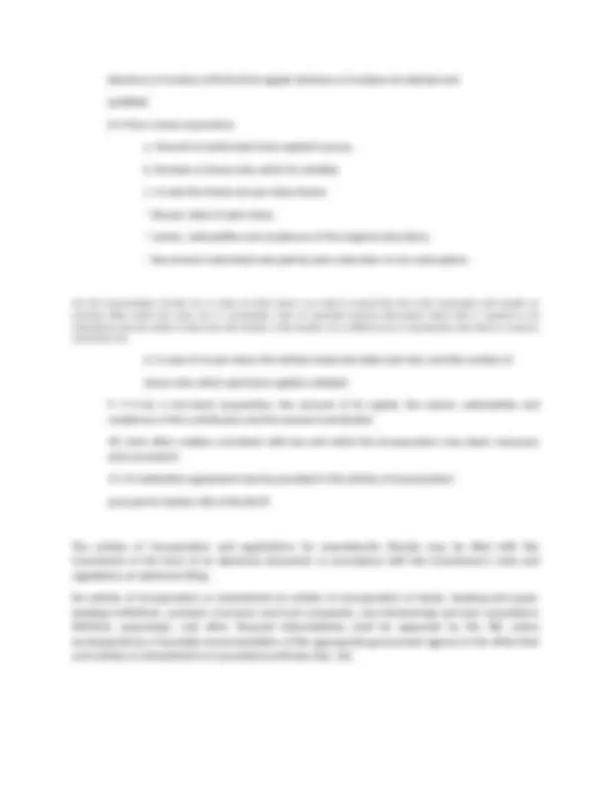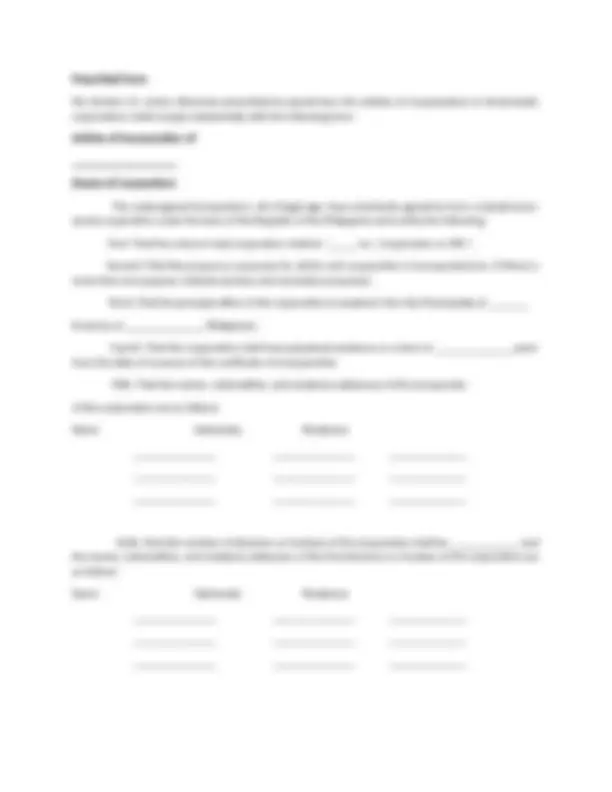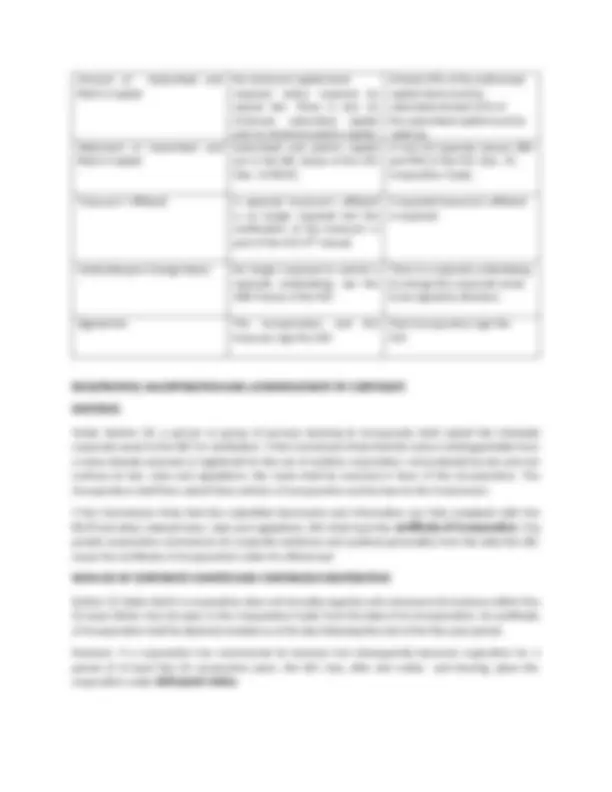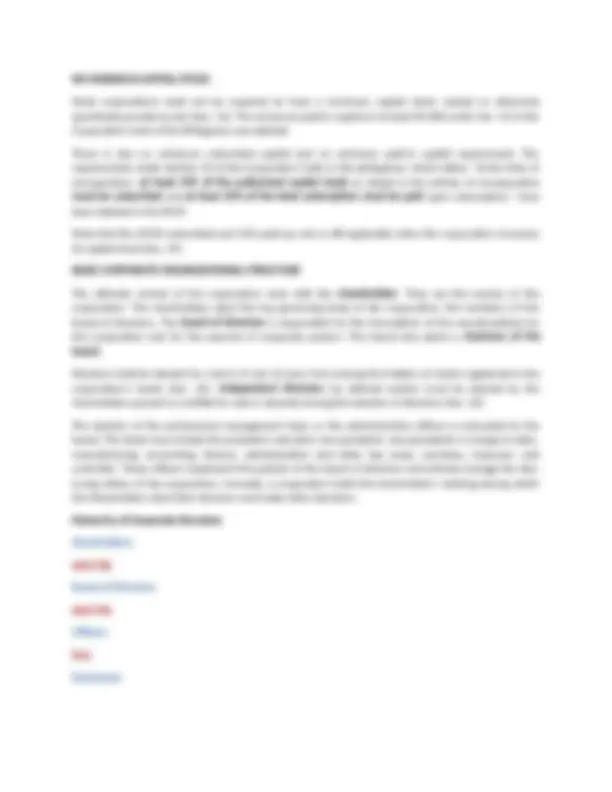













Study with the several resources on Docsity

Earn points by helping other students or get them with a premium plan


Prepare for your exams
Study with the several resources on Docsity

Earn points to download
Earn points by helping other students or get them with a premium plan
Community
Ask the community for help and clear up your study doubts
Discover the best universities in your country according to Docsity users
Free resources
Download our free guides on studying techniques, anxiety management strategies, and thesis advice from Docsity tutors
It is about the subject partnership corporation. It is about all the chapter 14 topics.
Typology: Lecture notes
1 / 19

This page cannot be seen from the preview
Don't miss anything!












14 Basic Financial Accounting & Reporting Corporations: Basic Considerations Learning Objectives: fter studying this chapter, you should be able to:
scope remains for strengthening the role of SMES In the Philippine economy if tha traditional hurdles in access to finance, technology, raw materials and markets can h vercome. Adapted portions from "Small Business and ASEAN Integration," By Dr. Cielito Hobto of Philippine Daily Inquirer, Sept. 30, 2014. One way in which corporations raise new capital is by issuing shares of stock. In the early months of 1992, General Motors Corporation, the major car-Chevrolet, Pontiac, Buick and Cadillac-maker in North America, successfully issued 55 million ordinary shares at US$39.0 per share, raising more than US$2.1 billion. It was the fourth time in two years that G.M. had raised funds by issuing shares. What are some of the possible reasons why G.M. would have chosen a share issue over other ways of raising capital? There are definite advantages to financing with share capital. First, equity financing-the method of obtaining funds by issuing ordinaryor preference shares-is less risky than debt financing-issuance of bonds, notes or mortgage, because dividends on ordinary shares are not paid unless declared by the board of directors. In contrast, if the interest on bonds, notes or mortgage payable is not paid, a corporation may be forced into bankruptcy. Second, when a corporation does not declare cash dividends, the cash from profitable operating activities may be invested to finance expanded operations. Third, a corporation may need the proceeds from an ordinary share issue to improve the balance between liabilities and shareholders' equity. It is important for accountants to understand the nature and characteristics of corporations as well as the process of accounting for a share issue and other types of share transactions. Adapted from " G.M. Issue Lands and Price Holds Up," By Susan Antilla of New York Times, May 21, 1992. REVISED CORPORATION CODE Republic Act 11232, otherwise known as the Revised Corporation Code of the Philippines (RCCP), was signed into law by President Rodrigo Duterte on Feb. 20, 2019 and became effective Feb. 23, 2019. For over 39 years, the Corporation Code of the Philippines (Corporation Code) or Batas Pambansa Blg. 68, was the law that governed corporations. The Corporation Code took effect on May 1, 1980. Not all of the provisions of the Corporation Code were amended by the RCCP, but Congress decided to re-enact the unchanged provisions and include new provisions in order to pass a complete Revised Corporation Code of the Philippines. The first general law on corporations in the Philippines, which was practically a codification of the American law on corporations, was the Corporation Law or Act 1459. The Philippine Commission passed this law and it took effect on Apr. 1, 1906. The RCCP aims to introduce the following reforms: Policies that would enhance the ease of doing business in the Philippines, Rules that prioritize corporate and stockholder protection Provisions that instill corporate and civic responsibility; and Amendments that will strengthen the country's policy and regulatory corporare framework.
Section 3 of the RCCP classified private corporations into:
A. Close corporation. A corporation whose share ownership is limited to selected persons or members of a family not exceeding 20 persons. B. Open corporation. A corporation where the share is available for subscription or purchase by any person. C. Publicly-held corporation. A corporation with a class of equity securities listed on an exchange or with assets in excess of P50,000,000 and having 200 or more holders, at least 200 of which are holding at least 100 shares of a class of its equity securities (SRC Rule 3-1.M, Amended IRR of the Securities Regulations Code (R.A. 8799).
Prescribed Form Per Section 14, unless otherwise prescribed by special law, the articles of incorporation of all domestic corporations shall comply substantially with the following form: **Articles of Incorporation of
(Name of Corporation)** The undersigned incorporators, all of legal age, have voluntarily agreed to form a (stock)/(non- stock) corporation under the laws of the Republic of the Philippines and certify the following: First: That the name of said corporation shall be "_____ Inc., Corporation or OPC"; Second: That the purpose or purposes for which such corporation is incorporated are: (If there is more than one purpose, indicafe primary and secondary purposes): Third: That the principal office of the corporation is located in the City/Municipaliy of _______ Province of ______________, Philippines; Fourth: That the corporation shall have perpetual existence or a term of ______________ years from the date of issuance of the certificate of incorporation Fifth: That the names, nationalities, and residence addresses of the incorporato of the corporation are as follows: Name Nationaity Residence
Sixth: that the number of directors or trustees of the corporation shall be ____________; and the names, nationalities, and residence addresses of the first directors or trustees of the corporation are as follows: Name Nationaity Residence
Seventh: That the authorized capital stock of the corporationn is ___________ PESOS(P _____),divided into shares with the par value of ________PESOS (P __________) per share. (In case all the shares are without par value): That the capita stock of the corporation ___________ is shares without par value. (In case some shares nave par value and some are without par value): That the capifal stock of said corporation consists of ___________ shares, of which ___________ shares have a par value of ____________ PESOS (P ________)each, and of which _________ shares are without par value. Eighth: That the number of shares of the authorized capital stock above stated has been subscribed as follows: Name of Subscriber Nationality No. of Shares Subscribed Amount Subscribed Amount Paid (Modify No. 8 if shares are with no par value. In case the corporation is non-stock. Nos. 7 and 8 of the above articles may be modified accordingly, and it is sufficient if the articles state the amount of capital or money contributed or donated by specified persons, stating the names, nationalities, and residence addresses of the contributors or donors and the respective amount given by each.) Ninth: That has been elected by the subscribers as Treasurer of the Corporation to act as such unfil after the successor is duly elected and qualified in accordance with the by-laws, that as Treasurer, authority has been given to receive in the name and for the benefit of the corporafion, all subscriptions, Contributions or donations Paid or given by the subscribers or members, who certifies the information set forth in the eventh and eighth clauses above, and fhaT he paid-up portion of the subscription in ash and/or property for the benefif and credit of fthe corporation has been duly received. Tenth: That the incorporators underfake to change the name of the corporation ediately upon receipt of notice from the Commission that another corporation, partnership or person has acquired a prior right to the use of such name, that the name has been declared not distinguishable from a name already registered or reserved for the use of another corporation, or that it is confrary fo law, public morals, good custom or public policy. Eleventh: (Corporations which will engage in any buSiness or activity reserved for Filipino citizens shall provide the following): "No transfer of stock or interest which shall reduce the ownership of Filipino citizen to less than the required percentage of capifal stock as provided by existing laws shall be allowed or permitted to be recorded in the proper books of the corporation, and this restriction shall be indicated in all stock certificates issued by the corporation."
Amount of Subscribed and Paid-In Capital No minimum capital stock required unless required by special law. There is also no minimum subscribed capital and no minimum paid-in capital. At least 25% of the authorized capital stock must be subscribed at least 25% of the subscribed capital must be paid-up. Statement of Subscribed and Paid-In Capital Subscribed and paid-in capital are in the 8th clause of the AOI (Sec. 14 RCCP). In two (2) separate clauses (8th and 9th) of the AOI, (Sec. 15, Corporation Code). Treasurer’r Affidavit A separate treasurer's affidavit is no longer required but the certification of the treasurer is part of the AOI (9th^ Caluse) A separate treasurer's affidavit is required. Undertaking to Change Name No longer required to submit a separate undertaking, see the 10th Clause of the AOI There is a separate undertaking to change the corporate name to be signed by directors. Signatories The incorporators and the treasurer sign the AOl. Only incorporators sign the AOI. REGISTRATION, INcORPORATION AND cOMMENCEMENT OF CORPORATE EXISTENCE Under Section 18, a person or group of persons desiring to incorporate shall submit the intended corporate name to the SEC for verification. If the Commission finds that the name is distinguishable from a name already reserved or registered for the use of another corporation, not protected by law and not contrary to law, rules and regulations, the name shall be reserved in favor of the incorporators. The incorporators shall then submit their articles of incorporation and by-laws to the Commission. If the Commission finds that the submitted documents and information are fully compliant with the RCCP and other relevant laws, rules and regulations, SEC shall issue the certificate of incorporation. The private corporation commences its corporate existence and juridical personality from the date the SEC issues the certificate of incorporation under its official seal. NON-USE OF CORPORATE CHARTER AND CONTINUOUS INOPERATION Section 21 states that if a corporation does not formally organize and commence its business within five (5) years (Note: two (2) years in the Corporation Code) from the date of its incorporation, its certificate of incorporation shall be deemed revoked as of the day following the end of the five-year period. However, if a corporation has commenced its business but subsequently becomes noperative for a period of ot least five (5) consecutive years, the SEC may, after due notice and hearing, place the corporation under delinquent status.
A delinquent corporation shall have a period of to (2) years to resume operations and comply with all requirements that the SEC shall prescribe. Upon compliance by the corporation, the SEC shall issue an order lifting the delinquent status. Failure to comply with the requirements and resume operations within the period given by the SEC shall cause the revocation of the corporation's certificate of incorporation. The SEC may also place the corporation under delinquent status in case of failure to submit the reportorial requirements three (3) times, consecutively or intermittently, within a period of five (5) years (Sec. 177). BY-LAWS These are the rules of action adopted by the corporation for its internal government and for the government of its officers, shareholders or members. Under Section 46, a private corporation may provide in its by-laws for:
Section 24 states that the president of a corporation must be a director of the corporation, but he cannot act as president and secretary or as president and treasurer at the same time. The president is the only officer required by law to be a directorer The corporate secretar y must be a resident and a citizen of the Philippines. He need the not be a director unless required by the corporate by-laws. It is generally the duty of the secretary to make and keep its records and to make proper entries of the votes, resolutions and proceedings of the shareholders and directors in the management of the corporation. The corporate treasurer is the proper officer entrusted with the authority to receive and keep the money of the corporation and to disburse them as he may be authorized. The treasurer may or may not be a director but is now required per. 24 of the RCCP to be a resident of the Philippines. If the corporation is vested with public interest, the board shall also electa compliance officer (Sec. 24). There is no prohibition in the law against a shareholder being a director or officer of two or more corporations. The Corporation Code does not prohibit a corporate officer from Occupying the same position in another corporation organized for the same purpose. However, such situation may be prohibited by special law, the articles of incorporation or the corporate by-laws. There is a particular case involving a business tycoon who wanted to become a San Miguel Corporation director although he was already ocupying the same post in two corporations directly competing with the food and beverage giant. At that time, San Miguel amended its by-laws to provide for the disqualification of a shareholder from being a director of the corporation if the former already occupies the same position in a competing firm. The Supreme Court later upheld the decision of San Miguel. Thus, a corporation is authorized to prescribe qualifications for its directors (Gokongwei vs. SEC, 89 SCRA 336). RIGHTS OF A SHAREHOLDER The following are some of the rights of a shareholder:
Every private corporation, stock or non-stock is required to keep books and records at its principal office of the following:
stating in such notice the names, residence residence, addresses and contact details of all known legal heirs." The single stockholder shall designate a nominee and an alternate nominee who shall, in the event of the single stockholder's death or incapacity, take the place of the single stockholder as director and shall manage the corporation's affairs. The articles incorporation shall state the names, addresses and contact details of the nominee and alternative nominee as well as the extent and limitations of their authority in managing the affairs of the OPC. The written consent of the nominee and alternate nominee shall be attached to the application for incorporation. Such consent may be withdrawn in writing any time before the death or incapacity of the single stockholder (Sec. 124). The single stockholder may, at any time, change its nominee and alternate nominee by submitting to the SEC the names of the new nominees and their corresponding written consent. For this purpose, the articles of incorporation need not be amended (Sec. 126). A One Person Corporation shall maintain a minutes book which shall contain all actions, decisions, and resolutions taken by the OPC (Sec. 127). Records in Lieu of Meetings. When action is needed on any matter, it shall be sufficient to prepare a written resolution, signed and dated by the single stockholder, and recorded in the minutes book of the OPC. The date of recording in the minutes book shall be deemed to be the date of the meeting for all purposes under the RCCP (Sec. 128).